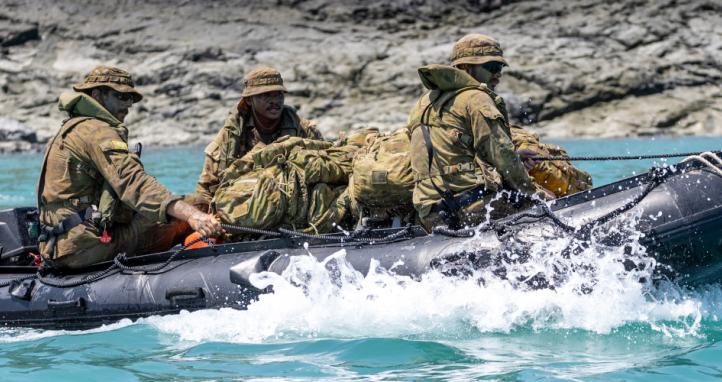INTRODUCTION
The requirements for service within the military necessitates the need for a high level of physical and mental preparedness and robustness. Dependent on the branch of service, corps, trade or unit; a soldier may require both the physical and mental capacities that could be likened in some ways to those required at the elite athlete/Olympic athlete level. For many years, Army physical training has been synonymous with long slow distance endurance running, combat load-carriage marching, and high repetition circuit-based training (1-5), where poor form and repetitive overuse injuries are common place. Coupled with this, the mindset that ‘more is more’, and that individuals need to walk away from training sessions so fatigued that they cannot function for days afterward in order to get any benefit. Now with the inclusion of a more evidence-based strength and conditioning training approach it is understood that this has never been the case, and that ‘more is often less’; whereby, long-term athlete development is paramount, and periodised strength and conditioning coupled with appropriate recovery protocols are essential in ensuring the wellbeing and longevity of combat athletes. This is not to say that these aerobic/endurance-based modalities need be stricken from the training regime completely; however, the focus on training has needed to shift to ensure that whilst aerobic fitness and muscular endurance are important, they shouldn’t necessarily take precedence. Combat athletes more importantly require strength, power, speed (1-5) and many other components of fitness that often get overlooked when programming. This article seeks to highlight the considerations that need to be made when programming for combat athletes, and the underlying factors that at times affect their adherence to strength and conditioning programs.
ATHLETE CONSIDERATIONS
Whilst there are similarities between the resistance training conducted for a combat athlete compared with that of a field sports or track based athlete, the soldier has many other pressures and external factors that influence the overall effectiveness of a training program that they may be undertaking; either collectively or as an individual. These factors can be determined by whether a soldier is in training on barracks, out field on exercise, or away on operational deployment. Some of these factors are, but not limited to; access to facilities and equipment, group training size, temporal factors that may negate training or reduce the training time available, access to adequate nutrition and recovery strategies, lack of adequate sleep.
Access to Facilities and Equipment
Although over recent years the inclusion of strength training equipment (incorporating rigs, platforms, Olympic bars and bumper plates) within most Army establishment gyms has increased. However, the access to it is sometimes restricted by the work commitments placed on soldiers due to unit tempo. Whilst most soldiers will endeavour to catch up on missed training sessions, this is not ideal when trying to follow a periodised training program.
Group training size
This issue is also linked to that of facilities and equipment, as unlike a sports team program, Army training sessions may at times involve up to over 100+ personnel, which therefore reduces the capacity for physical trainers or fitness leaders to conduct allocated sessions to best effect. These large group numbers limit the availability of equipment and impacts on the trainer’s ability to effectively coach and fault correct when compared with a smaller sized group dynamic.
Temporal factors
Like the issues of facilities and equipment, the temporal factors placed on soldiers sometimes inhibit them from completing all the necessary training sessions within a given training block. Also, the time allocated for certain sessions can be cut short due to other commitments; therefore, not allowing the full completion of that individual training session. Again, this is not an ideal situation and may mean that during a given block of training, soldiers may miss certain components of fitness; whether that be strength, energy system development, speed or allocated recovery sessions.
Nutrition, Recovery and Sleep
Again, due to factors outside of soldiers control, they may not always have the time or access to appropriate nutritional and recovery strategies dependent on the environment and time of day they are operating. This also has an impact on their individual sleep habits and in some cases restricts their recovery due to inadequate hours of sleep prior to the next training session.
NEEDS ANALYSIS
Due to the nature of soldiering and the impact of the above-mentioned factors it remains challenging to determine the most appropriate strength and conditioning plan for a combat athlete, given the fact that each soldier, dependent on their corps or trade has different physical requirements for their role. This can also be constantly changing dependent on the environment that they are operating in. As stated previously, soldiers require a high level of muscular and cardio respiratory endurance, which cannot be argued. The importance of strength, power and speed, however, has again often been overlooked, and a needs analysis would seek to determine through literature review and subject matter expertise the most effective way of developing periodised strength and conditioning programs for combat athletes.
PROGRAM DESIGN
Given the temporal and group size factors that have already been discussed, the program design in Tables 1 and 2 were developed to best accommodate several training components/modalities in to an easy to use, self-populating program that can either be conducted collectively or individually and ensures that either hypertrophy/strength, power, supplementary/accessory exercises and components of metabolic conditioning are included.
Resistance Training
The examples in Table 1 and 2, respectively show a four-week hypertrophy or strength block for a combat athlete. This includes three weeks of linear progression, using the basic periodisation principles of Wendler 5-3-1, incorporating progressive overload (6-9) and followed by a de-load week prior to phase change. The strength block would typically be conducted as a peak phase prior to a major exercise/activity, where the athlete would be away for an extended period with no access to training facilities, prior to them returning into a hypertrophy period to build on muscle atrophy which has been lost during the non-training period. Each week within the training block is broken in to four training days; typically, Monday, Tuesday, Thursday, Friday, with Wednesday being a rest/recovery day. Each of these four training days targets a specific gross movement pattern (i.e. lower body push, upper body vertical pull, lower body pull, upper body horizontal push). Following an adequate warm-up and movement preparation, these movement patterns are trained at the start of the session during the heavy working sets. Incorporating contrast training, a potentiation exercise is coupled with these heavy working sets to elicit a neuromuscular response and increase explosive power (10-12). The remaining supplementary/accessory exercises can either be conducted as normal sets or as a form of energy system development, using a circuit-based approach. The remaining exercises target movement patterns such as hinge mechanics, upper body vertical push, single leg lunging patterns, torso flexion, torso rotation, torso stabilisation/anti-rotation, and isolation movements. Typically, in a working week a combat athlete may only have 4-5 allocated sessions were they can conduct organised training; therefore, the modified Wendler 5-3-1 program forms a solid foundation as it targets the main four lifts of squat, pullup, deadlift and bench press, whilst also having the time to incorporate supplementary and accessory exercises to target the remaining movement patterns. The program is simple and effective to program for and makes athletes accountable, also ensuring a de-load week at the end of each four-week block, which is in some ways forced recovery, and typically an area that soldiers tend to overlook. Following the completion of a block of training the primary strength movements, potentiation exercises, supplementary/accessory exercises will be varied utilising some of the examples in Table 3.
Post-activation potentiation (PAP) refers to the excitation of the neuromuscular system; whereby the completion of a heavy strength exercise (e.g. 1RM back squat or bench press) preceding a similar lower or upper limb power-based movement has been shown to increase muscular explosive power (10-12). Within the program there is a combination of both low load, high velocity plyometric movements (e.g. medicine ball exercises, jumping and bounding) and mid-high load, mid-low velocity Olympic lifting movements (e.g. power clean, power snatch, hip-thrusts, bench press throw).
Energy System Development
A combat athlete requires a high level of conditioning in all three sub-sets of energy system development (i.e. aerobic, glycolytic, ATP-PC). Overall, soldiers require a good aerobic system as its sets the foundation for most tasks/functions that they are required to perform both in barracks and on exercise/deployment. Many general tasks that they perform are aerobic in nature (i.e. sub-maximal intensity); however, they do these carrying external loads (e.g. belt/chest webbing, combat body armour, helmet and weapon system). Depending on their job/role, soldiers also require and excellent glycolytic system as they are required to work with the same external load; however, they perform shorter duration but higher intensity tasks where they have minimal rest between bouts/efforts (e.g. infantry soldier conducting fire and movement). Most soldiers also require and excellent ATP-PC system to conduct the fast, explosive movements that would be seen in most sports and for numerous generic solider tasks. Examples of energy system development sessions and a suggested weekly microcycle example are listed in Table 4 and 5.
RESULTS
Whilst from an observational and qualitative perspective there was an overall increase in strength following generic athlete 1RM testing, these results are anecdotal as there was no specific battery of tests conducted prior to and post training blocks; in part due to external factors that where detailed previously. In relation to power, again it could not be determined whether the PAP had any effect on athlete performance following heavy strength exercise; although through qualitative feedback the athletes found that these strength/potentiation exercises had aided them in applicable job tasks within their work environments.
About the author: Robbie Dunlop is the current Sergeant Physical Training Instructor posted to the Trainee Rehabilitation Wing (TRW). He has over 16 years’ experience, with the previous four years spent working within Special Operations Command. Robbie is an ASCA Level 2 Strength and Conditioning Coach and is currently in his final year of completing a Bachelor of Sport and Exercise Science with Western Sydney University, prior to commencing a Masters of Strength and Conditioning. Robbie has a keen interest in the human performance optimisation of the combat athlete; including the areas of strength and conditioning, biomechanics, load monitoring and fatigue management.







